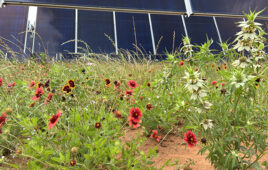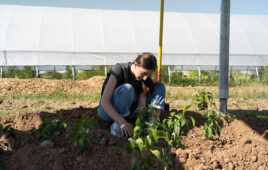Vegetation control on large ground-mount solar installations is often an overlooked cost. In the grand scheme of things, that $25,000 a year to send out lawn mowers and weed whackers on a multi-megawatt project isn’t the highest ticket item to worry about lowering. But what if you could reduce vegetation control costs by 50% or more? Wouldn’t it be worth checking out?
Enter the rising trend of using animals to control grass and weed growth. Goats and sheep seem to be the most popular choices, but even emus are used on Japanese solar farms. While animal-driven vegetation control has taken root in Europe and Asia, it’s been slow to catch on in North America. A growing number of local success stories shows that could be changing.
OCI Solar Power hosts sheep on one of its Texas projects, as does KDC Solar on some of its New Jersey projects. NextEra Energy has enlisted the help of about 50 sheep on a 25-acre section of one of its Florida solar projects and said results are promising. New venture Goat Grazers Ontario has been working on debunking goats-eat-everything-even-wires myths and has bred a special goat that has found speedy success on Canadian solar farms.
It seems like it’s finally time in North America to pay attention to the benefits of using four-legged greenery eating machines instead of diesel-guzzling hunks of metal to control vegetation growth, limit the release of harmful fumes and curb O&M costs.
 The case for goats
The case for goats
Goat Grazers Ontario started off as a 91-acre goat sanctuary and small-scale vegetation control business before herd manager Tamara Follett realized the surrounding area near Kingston, Ontario, was ripe with solar farms that needed help controlling weeds. After one successful solar farm client, Goat Grazers Ontario started a “designer” breeding program to raise goats perfectly suited to eat around solar farms.
The group starts with Nigerian Dwarfs—historically from flat lands so they don’t have the climbing instinct of common Alpine goats (from mountainous areas), but they lack the cold tolerance needed for Canadian winters. When paired with Spanish Cashmere breeds (which have cold tolerance and are tough), these new, smaller goats fit perfectly under solar panels, don’t jump and can survive cooler temperatures.
“We decided to focus on what we’re calling solar goats,” Follett said. “We want a short statured animal with a very big stomach. They look like a normal sized goat, but they have short legs.”
Goats have large stomachs, divided into four chambers, so they feel the need to eat constantly. And Follett said the goats on the solar farms have been eating everything—grass, weeds, poison ivy, maple and more.
“The goats prefer the weeds and will eat the weeds first,” she said. “Some of the fast growing brush that we have in Ontario is poplar, Manitoba maple—you can’t kill it. The goats eat it down to a stick, and then the stick dies and doesn’t come back. It’s amazing what they can do. They have cast iron stomachs.
“It’s an old wives’ tale that goats will eat anything they can find,” she continued. “They will put anything in their mouths, but they only like green. They’ll spit out everything else. They don’t chew on wires, they don’t chew on paper, they don’t eat tin cans. They’re driven to eat all the time, and if it doesn’t taste good, then they won’t eat it.”
 Goats are dropped off at the solar farms in the spring and moved around from zone to zone or left alone. Follett said the team first checks in on the goats twice a day to make sure everything is going well then pops by less as they become more familiar with the landscape. Solar farms often already have good protection from predators with tall perimeter fences, and the solar panels provide enough shelter from the elements if the goats ever need refuge.
Goats are dropped off at the solar farms in the spring and moved around from zone to zone or left alone. Follett said the team first checks in on the goats twice a day to make sure everything is going well then pops by less as they become more familiar with the landscape. Solar farms often already have good protection from predators with tall perimeter fences, and the solar panels provide enough shelter from the elements if the goats ever need refuge.
In general, weeds need to be eaten down to the ground twice a season, but the goats are picked up once the job is done—they’re not left out on a solar farm year-round. For Goat Grazers Ontario’s first solar project, Follett estimated it would take 40 goats six weeks to clear 17 acres. The goats surprised everyone by finishing the project in just two weeks.
“Goats really provide a no-brainer solution to keeping vegetation down, and it’s reasonable,” Follet said. “It’s $20 per goat per week. That’s really inexpensive. We spend more on Starbucks.”
Goat Grazers Ontario is actively looking for more solar clients, and Follett expects 300 animals to be “employed” in the next year. The group is fully insured, just in case goats do damage, but that is highly unlikely with this short-statured, non-jumping breed of “solar goats.”
Tried-and-true sheep
Rob Simalchik, vice president of operations and construction at KDC Solar, had been looking into bringing sheep onto the developer’s large commercial solar arrays for years, but no one seemed to be interested in his mission.
“I was unable to find anyone that was interested in providing the sheep,” he said. “I even talked to the sheepherder’s association in New Jersey.”
 Two years ago, by a stroke of good luck, a shepherd approached KDC Solar, indicating she was willing to give solar farms a try. Simalchik went ahead with it and has been amazed by the results.
Two years ago, by a stroke of good luck, a shepherd approached KDC Solar, indicating she was willing to give solar farms a try. Simalchik went ahead with it and has been amazed by the results.
“We introduced sheep to the smallest ground site we had, to use it as a test base. It’s 16 acres inside the fence,” he said. “It couldn’t have gone any better. The grass was kept at a low height. They got everywhere. It’s one of those win-wins where I am getting rid of the zero-turns, getting rid of the weed whackers, getting rid of those fumes, carbon monoxide, carbon dioxide—replacing it with something that is so correct for basically a pasture. It really works.”
After seeing a 50% reduction in vegetation O&M costs on this test site (a 2.2-MW system in Vineland, New Jersey), Simalchik has expanded to a second site (a 6.1-MW tracking system at Lawrenceville School) and plans for an under-construction solar farm to host 80 sheep during the grazing season.
Similar to Ontario’s goats, the sheep used on the KDC Solar projects are brought in around mid-April and then sent back to sheep HQ in October. Shepherd Julie Bishop uses the winter to birth some new recruits and grow the flock.
“There’s a little more to [using sheep for vegetation control] than calling a landscaper and having them show up with their lawn mowers,” Simalchik said. “She brings them into the first 16-acre site as very young lambs and leaves a few older ones there to show them the ropes. She uses that 16-acre site as the nursery. Then she’ll populate the other sites as they get older. There’s thought behind it. You don’t just go throwing sheep into an area. You get them ready to get into that area.”
Sheep are used to wide-open pastures, so additional shelters are not necessary on solar farms. KDC Solar did install an electric fence along the perimeter of the existing chain-link fence at one site for added protection from predators like coyotes.
The sites also host portable plastic tubs that hold about 250 gallons of water so the sheep stay hydrated. KDC officials and the shepherd can see water levels via security cameras and will visit the sites to fill up the tanks.
Otherwise, using sheep for vegetation control is a painless, hands-off process that Simalchik is surprised more solar farm operators are not looking in to.
“My guess is that it takes a little more effort. It’s very easy to pick up the phone and call a landscaper,” he said. “I think there aren’t a lot of shepherds interested in it. Once they get involved in it, they see that it is relatively easy to do and they are compensated. It’s a win-win for us and the shepherd.”
While not a big-ticket item, vegetation management at solar farms isn’t going to go away, and why not try to save some money?
“The Lawrenceville school (26 acres) was costing $25,000 a season to cut. With a shepherd, it’s $10,000,” Simalchik said. “It may not sound like an awful lot, but over the life of the PPA, on that one site, it adds up.”





one of the additional hazards that comes along with mowing is throwing rocks (in a field of glass!). That is negated with sheep. HellermannTyton recently did a webinar about O&M and discussed this very topic. One thing to note about goats, the like to climb on things. With a heavy tilt, it may be less of a concern, another concern is goats chew on everything! Including wires! It seems that sheep are a overall better option.